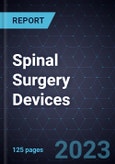Transformational Growth Driven by Digitally Led Business Models
The aim of this study is to analyze the innovative spinal surgery devices propelling market growth as the adoption rate of minimally invasive surgery (MIS) increases in the spinal surgery sector. The study highlights the latest technological solutions in the spinal surgery devices market, which include spinal fusion devices and spinal non-fusion devices, as well as companies’ business models and recent advances that meet present-day challenges.
The geographic scope comprises North America; Europe; Asia-Pacific; the Middle East, North Africa, and South Asia (MENASA); and Latin America and the Caribbean.
This market is transitioning from fusion to motion preservation, and the appeal seems immediate for dynamic and remote-controlled implants of the future. As such, the study aims to provide an understanding of two main areas, AI/data science and smart implants.
- AI and Data Science: The use of AI and data science will likely make predictability and optimal patient outcomes the standard of care for spinal surgery.
- Smart Implants: Smart implants are inserted during surgical procedures (in-patient and out-patient) and then non-invasively adjusted post-operatively. They can be programmed or remotely adjusted slowly over time via radio communication between the surgeon and the device.
This research delivers a detailed analysis of market sizing, trends, competitive landscape, future market outlook by region, and growth opportunities. It focuses on technology, connectivity, and new pathways for spinal surgery. The competitive analysis includes company market share for spinal surgical devices as well as market sizing analysis that covers historical and forecast revenue and volume data by region and segment. The study period is 2020–2027, with forecasts beginning in 2023.








